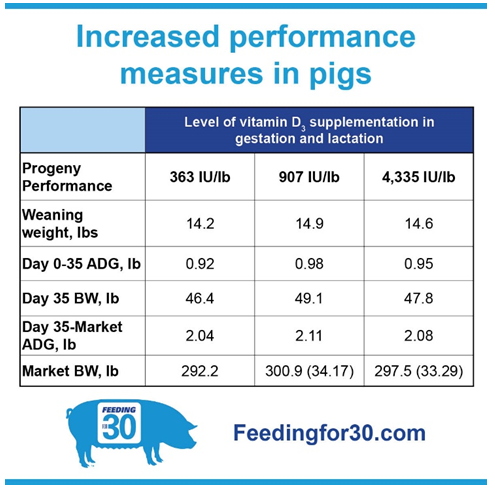



Research Ties Sow Vitamin D Intake to Progeny Performance
Pork producers who want to get the most out of every ingredient in a sow diet can look to new research showing the value of supplementing vitamins at optimal levels.The most recent research, supported by DSM Nutritional Products and carried out at Kansas State University, shows that an optimum level of vitamin D3 supplementation in the sow diet can measurably impact the performance of sows and their progeny.
Additionally, the research shows a higher level of vitamin D3 supplementation doesn’t always support more benefits. For some criteria, the sows and their progeny performed best when the sows were fed an “optimum” rather than a high level of vitamin D3.
“We are seeing growing evidence that supplementing a sow’s diet with an optimal level of vitamin D3 can support her improved performance, as well as the lifetime performance of her progeny,” says Jon Bergstrom, Ph.D., senior technical support manager for DSM Nutritional Products.
“It is important to note ‘optimal’ doesn’t mean ‘as much as possible.’ We have tested varying levels of vitamin D3 supplementation, and the data is showing a moderate level of vitamin D3 supports better performance and growth than a higher or lower level.”
The three levels of vitamin D3 supplementation compared in the study included:
- 363 IU/lb (800 IU/kg), which is the vitamin D3 requirement recommended for sows by the NRC (2012) to prevent vitamin D deficiency.
- 907 IU/lb (2,000 IU/kg), which is the upper level of the range DSM recommends for sow supplementation (1,500 to 2,000 IU/kg).
- 4,355 IU/lb (9,600 IU/kg), which is a high level of vitamin D3 supplementation thought safe for sows.
Lactation and vitamin D3
A sow’s nutrient needs are three times higher during lactation than at other times in her production cycle. The research supported vitamin D3 supplementation as a tool to meet the sow’s nutrient needs.
Results showed sows fed the 907 IU/lb of Vitamin D3 more successfully maintained body condition during lactation. In addition, the research showed sows fed the 907 IU/lb of Vitamin D3 had the greatest average daily feed intake (ADFI) during lactation. The lowest ADFI was measured in sows supplemented with the highest vitamin D3 level.
“This research showed 907 IU/lb of supplemental vitamin D3 supported greater lactation feed intake and reduced sow weight loss. Not only were the sows eating more to nourish their pigs, they were maintaining body condition, which can improve subsequent reproduction and the pigs produced in the sows’ lifetimes,” says Bergstrom.
Increased performance measures in pigs
The research also showed the benefits of supplementing sow diets with an optimal level of Vitamin D3 extended beyond the sows themselves. Pigs produced by sows fed the diets with 907 IU/lb of vitamin D3 experienced:
- Greater post-weaning average daily gain (ADG) than pigs farrowed by sows fed the higher or lower level of vitamin D3.
- Greater than 8 pounds more weight gained from birth to market (176 days of age) when compared to pigs produced by sows fed the low level of vitamin D3, and nearly 3.5 pounds more weight gained than pigs from sows fed the high level of vitamin D3.
“These results show the importance of sow vitamin D3 supplementation goes beyond supporting the sows’ nutrition and performance,” Bergstrom says.
“This research also demonstrates sow nutrition can have a measurable impact on the progeny performance from birth to market, and that optimum vitamin nutrition for the sow can help the progeny reach their genetic potential.”
Swine producers, veterinarians and nutritionists can learn more about the Feeding for 30® Program and access nutritional resources by visiting Feedingfor30.com or Facebook.com/Feedingfor30.








